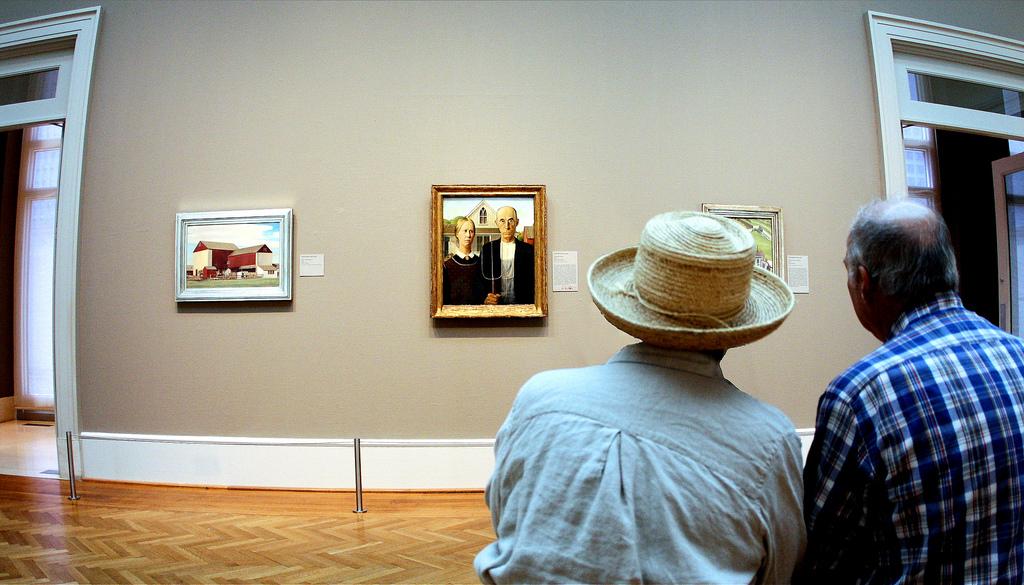4 ways museums will change over the next two decades
"American Gothic" on display at the Art Institute of Chicago.
There’s something calming about museums. Everyone moves slowly and seems engrossed by those rectangular plaques next to the paintings. Just imagine that pivotal scene in "Ferris Bueller's Day Off," where an otherwise troublemaking trio stops at the Art Institute of Chicago, takes a breath and begins to understand their place in the universe.
It can be tough to imagine such static institutions clawing their way into the 21st century, iPhone and FitBit in tow. But that’s exactly what museums should, and will, do, according to entrepreneur Brendan Ciecko and Elizabeth Merritt, the founding director of the Center for the Future of Museums.
Here are four ways the museum of 2030 will be radically different:
1. Pieces that pick up on your emotional response
There are some paintings, sculptures and historical artifacts that quicken the blood, make you feel engaged, and somehow, deeply human. Other pieces can bore you out of your skull. What if museums were able to know the difference? Not just whether a piece of art was critically acclaimed, but people’s specific emotional reactions. Brendan Ciecko says this isn’t out of the realm of possibility.
“I saw a fascinating demonstration in Switzerland where they were using biometric information, your heart rate and sweat when you responded, so like your emotional and physical response to the art, to determine certain things about your experience with the work. It’s the intersection of art, technology and science that makes this such a powerful time right now.”
With the Apple Watch and other wearable tech, devices that measure heart rate and body temperature are becoming more and more mainstream, making this an even bigger possibility. Ciecko thinks museums just need to find smart, interesting ways to use this data.
2. Multi-sensory experiences
Don’t touch the artwork! It’s been the clarion call of art institutes and museums since the dawn of museums. But Elizabeth Merritt thinks you might soon be able to get your grubby paws on Michelangelo's David, thanks to advances in technology.
“Why just look at these things? Why not have a haptic glove, a glove that can make it feel like I’m touching the piece that I’m looking at. Now that we have really good 3D digital scans of a lot of these objects, they can feed the data into a haptic glove, and it can make it feel like I’m touching something.”
Curious what Giacometti's knobbly sculptures would actually feel like? It could be a possibility. And what would the cafe in Hopper’s "Nighthawks" smell like? You might get an answer to that as well.
3. Beacons, beacons everywhere
Lots of people spend their entire museum visit glued to their smartphone. So, some museums are looking at smartphones to enhance exhibits. Ciecko started a company called Cuseum, which uses electronic beacons to do just that:
“As I get closer and closer to that particular art piece and I enter the viewing range, content can be delivered to my device seamlessly," he explains. "I didn’t need to scan anything or type anything into my phone. It becomes a very fluid experience.”
Apps, like the ones Ciecko designs, can give museum patrons a wealth of information, all tailored to what they’re actually interested by. Merritt is excited by the possibilities.
“The thing about the apps is, at their best, [they] let you choose an interpretive track that matches your interest. Maybe you don’t care about the medium in which the painting is done, maybe you don’t care about who collected it. You want to know who’s that guy in the painting, what’s his history? Or you want to know about that bird in the background.”
4. Augmented Reality
Google Glass might not have taken the world by storm, but that doesn’t mean augmented reality is dead. As it continues to develop, there are ways museums can tap into those opportunities. Merritt is reminded of a small child who believed that dinosaurs consisted solely of skeletons, because that’s what he saw in museums.
“There’s where an augmented reality app that shows the flesh on top of the bones, and shows the dinosaur walking, can really help make that leap from what you’re seeing, to what it represents.”
With museums' core audience growing older and whiter, Merritt feels that they need to come up with different, innovative ways to connect with a new audience. That can be augmented reality, apps, haptic gloves, body feedback, or — in specific cases — offering a space for viewers to purposely shut our technology-saturated world. By becoming part of our lives, Merritt believes, museums will become more and more relevant.
This story was adapted from an interview on the PRI radio show Innovation Hub.
